Auto parts PPC campaigns are becoming more critical to succeed online than ever.
Whether you are a small auto parts business or a national aftermarket auto parts retailer, Google Ads campaign can dramatically increase your website traffic and online sales.
There are plenty of PPC tips and tricks, but before going down the rabbit hole, you need to put together a PPC strategy that is meaningful. A PPC agency like FMDM can help you do just that.
Auto part business owners we talk to face one of two problems with their PPC campaigns.
They either struggle with building out campaigns that are structurally effective…
Or
They do not have the skill set in-house to actively manage and grow their auto parts PPC campaign.
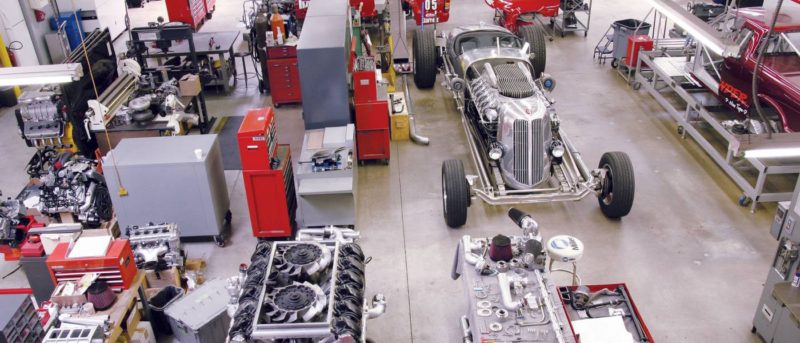
As a result, they outsource their automotive PPC to ad agencies and hope for the best. However, with precious marketing budget, simply hoping is not going to cut it.
In this article, I will share our proven PPC strategies and approaches we implement for our automotive clients — let’s dive in.
Aftermarket auto parts PPC is BIG business
According to Grand View Research, the global automotive aftermarket size was $335 billion.
Industry blog V12data.com expects the industry to reach $723 billion by 2020.
One of the biggest shows, Specialty Equipment Market Association (SEMA) is a testament of the magnitude of the aftermarket business.
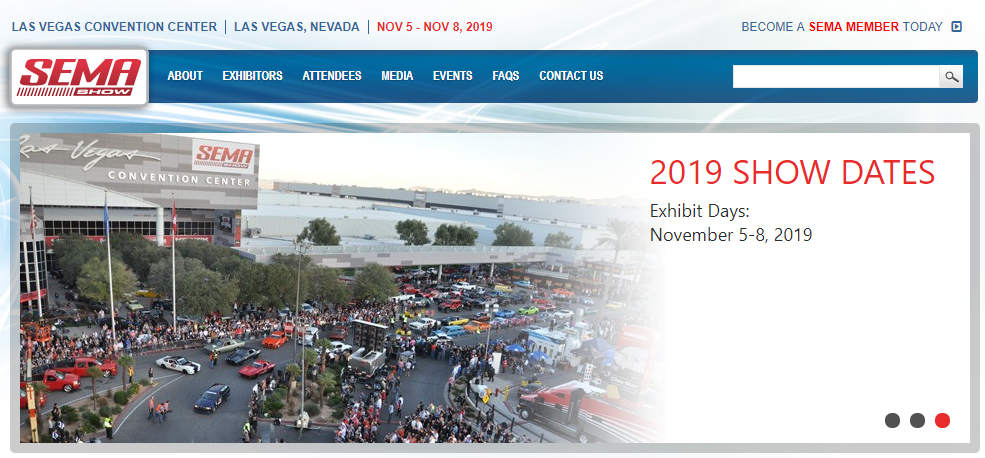
This is a show should on the list of conference for every auto enthusiasts.
As part manufacturers and retailers compete for a larger slice of this online customers, the competition gets tougher.
As a result, companies that integrate digital strategies and leverage internet marketing channels like pay-per-click will take the lead, get more customers, and drive growth.
Must-have Auto Parts PPC campaigns
A well-structured PPC campaign serves as the backbone of your entire pay per click strategy.
How you build out your campaigns should reflect your business objectives and support the tactics you plan to execute.
Brand campaigns
A brand campaign is built around your specific brand. For instance, our client BanksPower.com shows up for many combinations that include their brand keywords.
Search for “banks power.”
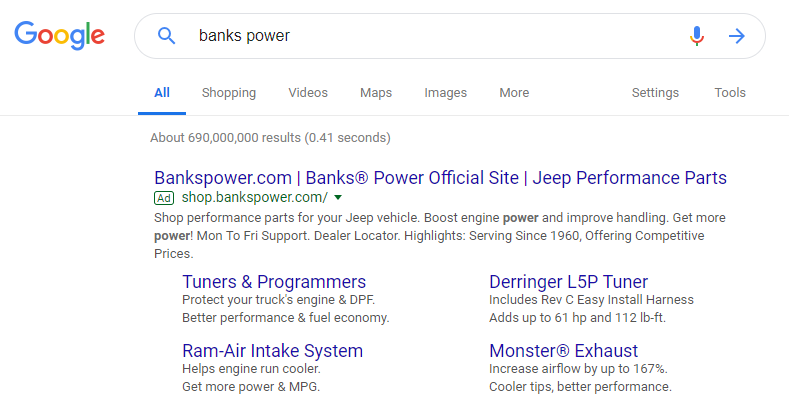
Keyword search for “banks diesel performance.”
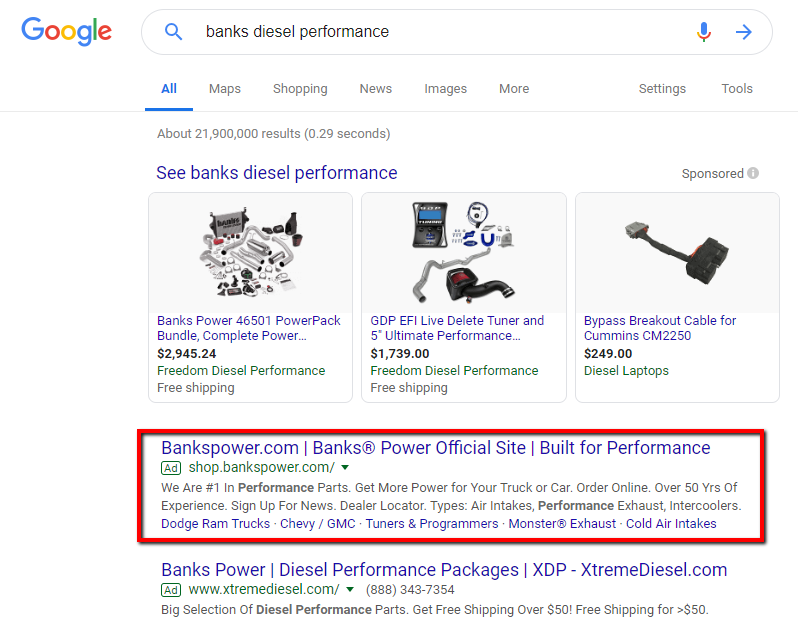
As you can see, competitors like XtremeDiesel.com is also bidding on “banks” related searches.
So imagine if we were’t defending our brand? Yea, you guessed it. Our client would be losing sales to the competition. And our auto parts PPC campaign would suffer.
A brand campaign is efficient, low costs, and high converting. This type of campaign is necessary especially if your brand is well known in the auto parts industry.
Additionally, it pushes your competitor further down the page who are trying to conquest your keywords.
People searching for your brand are already familiar with you — so branded automotive PPC campaigns will maximize trust and credibility.
In fact, brand campaigns will get a much higher click-through-rate (CTR).
Branded campaigns converts very well with brands that are established.
5 great reason to bid on your brand terms
- dominate the search results page
- control your brand message
- outrank your competitors’ ads
- high click rates and low CPCs
- convert customers near the point of conversion
Non-Branded campaigns
The opposite to brand campaigns.
These are campaigns that go after customers who are searching for aftermarket auto products.
The Duramax (DMAX) diesel engine is designed for the Chevy/GM trucks — and Banks Power manufactures the Derringer tuner for it.
So it is important for us to build a non-branded PPC campaign to bid for keywords like “duramax l5p tuner” and it’s variations.
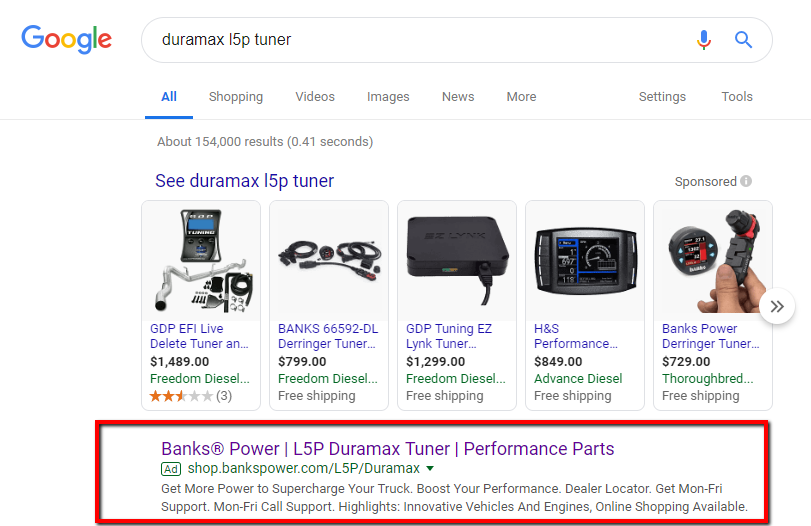
Non-branded keywords cost per click (CPC) is much higher than the branded keywords.
However, it is necessary to grow your business.
“But Derek, our branded campaigns are doing so well. Why do we need to bid on these expensive keywords?”
You’re right. But your branded campaigns are only seen by people who’re already familiar with your brand.
Advantages of non-branded campaigns include:
- putting your brand in front of new prospects
- gathering search data on things people want
- being relevant as a brand among the competition and in the market place
- drive more relevant website traffic
There is much more search volume for non-branded keywords; so you need to be cautious about monitoring your ad spend — to meet your business objectives.
Conquest auto parts PPC campaigns
Ever search for your brand and see your competitors’ ads?
It’s a common tactic used by advertisers, marketers, and aggregators to steal your branded traffic.
You can’t blame them — it’s a creative tactic.
But you can fight back! And you should.

Fair warning.
Your CPC will be considerably higher when you are bidding on your competitor’s brand.
But then you are going beyond the “enemy lines” when you target your competition. Right?
After all, it’s a dog-eat-dog world, and if you’re not bidding on their brand, you can rest assure they are bidding on yours.
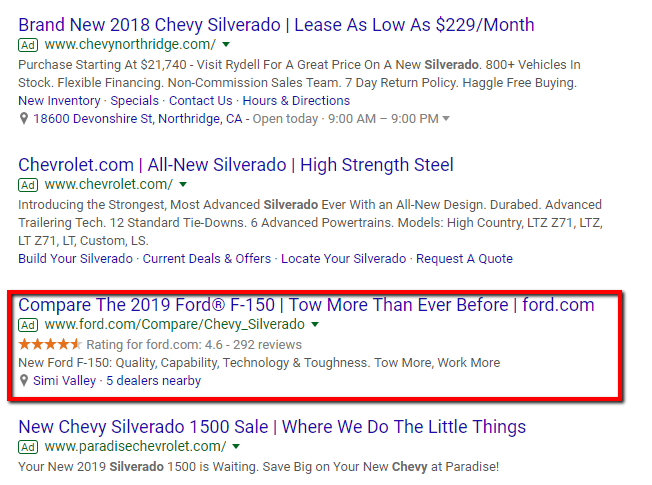
Ford’s conquesting paid search ads on a search for “chevy silverado”
Using targeted keywords, you can advertise your parts and accessories to the shoppers your competitors are targeting.
Shopping Auto Parts PPC Campaigns
Shopping PPC campaign is huge opportunity for any auto parts business to get highly targeted and relevant customers!
Shoppers are visual. Google is placing emphasis on their shopping listings.
The shopping ad are placed above the organic listings and the text search ads. According to DigitalCommerce360, shopping ads account for 76% of U.S. retailers ad spend.
As mobile shopping becomes more prominent, U.S. retailers are shifting their ad spend towards Google Shopping campaigns.
Aftermarket auto parts retailers is no exception. Google shopping campaign cannot be ignored if your brand wants to stay relevant and top of mind.
Search for “duramax tuner chevy” returns several players in the aftermarket performance space like Thoroughbreddiesel and FreedomDiesel among others.
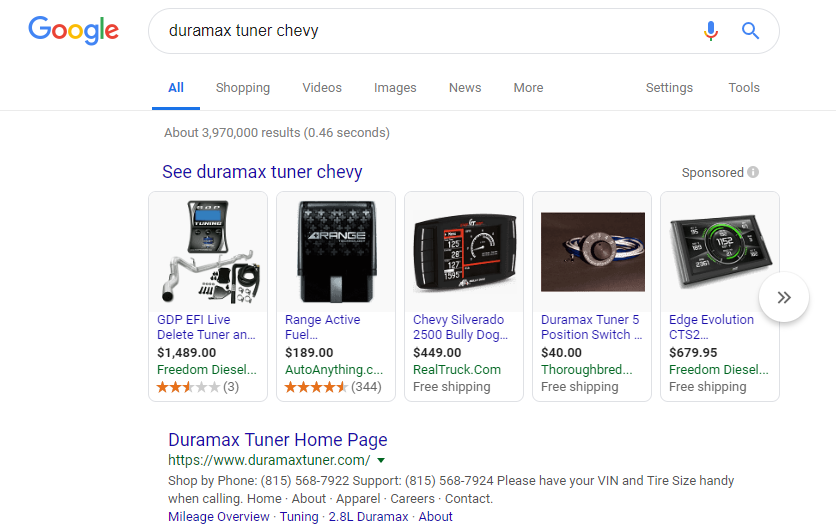
Aftermarket auto parts and accessory retailers can benefit from shopping campaigns — but they need to be strategic in approaching non-branded search terms.
That’s due to broad diversity of generic, product-based search terms that retailers need to compete on.
Reality of an online bidding marketplace is you can’t win in everything — but your shopping campaigns can certainly dominate in specific product categories.
It is important to plan, execute, and double-down on product categories that generate you the most profitable return.
Display Auto Parts PPC Campaigns
Display ads have taken a bad rep for many years.
Yes, the click-through-rates (CTR) is low. And conversion rates are negligible.
However, the metric to measure display PPC campaigns is not direct conversions — and definitely not first-touch conversions.
Why?
Because display campaigns are most effective at driving brand awareness, increase visibility, and value proposition reinforcement.
Let’s face it. If shoppers are not familiar with your brand, they’re not going to spend hundreds of dollars on aftermarket performance parts — right?
Display campaigns, whether it’s on YouTube, Google Display Network (GDN), Facebook, or other advertising platforms serve one primary purpose — grow your brand’s authority.
Advertising on auto sites like fourwheeler.com, will reach relevant audiences who are auto enthusiast.
Will this generate skyrocketing sales for Odyssey Batteries, most likely not. But what it will do is put Odyssey into the consideration cycle of shoppers. Brilliant!

Relevance is a big deal!
On the same token, there are some advertisers who have too much money to waste.
In reality, BestBuy.com has little relevance in display ads on a site like fourwheeler.com.
Their ad agency might argue otherwise, but there are better and more relevant sites to place display ads than this. (sorry BestBuy.com, I couldn’t resist!)

Retargeting / Remarketing Auto Parts PPC Campaigns
Aftermarket performance parts and accessories can be costly.
So, naturally it may take a longer sale cycle before a car owner buys from you.
If someone doesn’t buy from you on the first touch, don’t fret. They just need a little more convincing.
From our experience, the typical shopper for aftermarket upgrades will visit your website 3 times or more before buying from you.
A remarketing campaign lets you put your ad in front of people who visited your website, looked at your products, may have added to their cart — but did not complete their purchase.
Remarketing campaign has many options — there are many ways you can retarget your prospects.
- Remarketing lists for search ads (RSLA). So what is RSLA? RSLA is a feature in Google Ads that lets you customize your search ads campaign for people who have previously visited your site. Then adjust your bids and ad copy to these visitors.
- Dynamic display remarketing. You can tailor your ads to show shoppers the products they recently viewed or added to cart or products that’s most relevant to their site behavior.
- Up-sell remarketing. This will increase your average basket size for valued customers. With this campaign, you can up-sell complementary parts and accessories.
- Abandon cart remarketing. You will have shoppers adding items to their shopping cart, and leave for whatever reason. But all is not lost. You can target these abandoned shoppers with exclusive discounts, offers, or promotion to get them to complete their order.
- Reminder remarketing. This can work wonders, but needs to be execute with precision. Crafting your ad copy to “remind” a shopper to complete their purchase can drive incredibly high conversion rates.
- In-store remarketing. If you’re driving traffic into your retail stores, then this tactic can bring your shoppers into the store to complete their purchase. Think about “Buy Online Fulfill In-Store (BOFIS) to complete your shoppers cycle.
Remarketing campaigns will typically drive high return on ad spend (ROAS) when you are targeting the right audience with the most relevant ad copy, offer, and landing page.
Conclusion
The creation of an aftermarket product parts paid search strategy can get overwhelming. Auto parts PPC campaign management is complex but when done properly can drive incredible ROI.
It can help to remember that this is a big-picture road map to help set your business on the right path — make the right tactical decisions.
As part of your blueprint, you need to remember to focus on:
- Start with diligent keyword research
- Focus on your core objectives with defined metrics of success
- Go deep on your tactics to drive results
- Review, optimize, improve (R.O.I. with a new perspective)
At each step, take time to review and analyze and meet with key stakeholders to discuss your campaigns.
You can spend your marketing budget to scale your automotive business when you have absolutely clarity on how each campaign is performing.
Getting your team on board and thinking in the same direction will streamline the process of implementing your paid search strategy and help drive growth.
As always, if you have any thoughts or would like a little guidance on your auto parts PPC campaign, reach out at hello@fullmoondigital.com. We’d love to chat!

